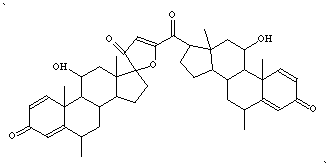E1041
AN INTERESTING STEROID DIMER WITH AN EXTREMELY LONG CELL AXIS: TETRAGONAL,
P41212, a=b=9.17Å,
c=85.90Å, V=7225.06Å3. Fusen Han and
Roger G. Williams, Pharmcia and Upjohn Inc., Kalamazoo, MI 49001, USA
An impurity in the methylprednisolone precursor was found in August of 1987
from five SOLU-MEDROL lots in the former Upjohn Company. It was the cause of
insoluble residues present in the reconstituted solutions. In support of the
structure determination, the analogous compound in the hydrocortisone series
was synthesized. In experiments on decomposition routes of hydrocortisone, a
sample dissolved in deoxygenated methanol was treated with 45% potassium
hydroxide. The crude product mixture was purified by chromatography on silica
gel with a chloroform eluant. One of the primary fractions proved to be a
dimeric condensation product whose structure was unknown.
The X-ray diffraction data of this compound were collected with
 Siemens
P4 diffractometer. The control software, XSCANS, could not determine the cell
from its default parameters. After modification, it derived a unusual
tetragonal cell: P41212, a=b=9.17Å,
c=85.90Å, V=7225.06Å3. To verify it's
extremely long c axis, three axial photos were taken. The cell
parameters were confirmed from these photos. 6839 reflections were collected
with [[Sigma]] scan at -40deg.C.
Siemens
P4 diffractometer. The control software, XSCANS, could not determine the cell
from its default parameters. After modification, it derived a unusual
tetragonal cell: P41212, a=b=9.17Å,
c=85.90Å, V=7225.06Å3. To verify it's
extremely long c axis, three axial photos were taken. The cell
parameters were confirmed from these photos. 6839 reflections were collected
with [[Sigma]] scan at -40deg.C.
The trial solution of this structure could not be easily obtained from the
direct methods either. The short a, b and extremely long c
axis could be the reason for the difficulties. The structure was finally solved
with 10,000 direct methods attempts using SHELXS program package. The structure
refinement is underway.
 Siemens
P4 diffractometer. The control software, XSCANS, could not determine the cell
from its default parameters. After modification, it derived a unusual
tetragonal cell: P41212, a=b=9.17Å,
c=85.90Å, V=7225.06Å3. To verify it's
extremely long c axis, three axial photos were taken. The cell
parameters were confirmed from these photos. 6839 reflections were collected
with [[Sigma]] scan at -40deg.C.
Siemens
P4 diffractometer. The control software, XSCANS, could not determine the cell
from its default parameters. After modification, it derived a unusual
tetragonal cell: P41212, a=b=9.17Å,
c=85.90Å, V=7225.06Å3. To verify it's
extremely long c axis, three axial photos were taken. The cell
parameters were confirmed from these photos. 6839 reflections were collected
with [[Sigma]] scan at -40deg.C.